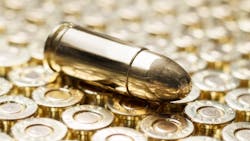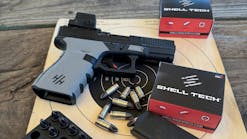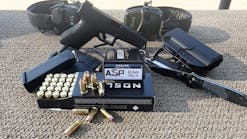Ammunition Shortage Puts Iowa Police, Others in a Pinch
By Kat Russell
Source The Gazette, Cedar Rapids, Iowa
With fall hunting seasons unfolding in Iowa and demand for ammunition rising, supplies are so tight that some retailers are rationing how much customers can buy and the state is warning hunters to plan ahead now or risk being surprised later.
The ammunition shortage became pronounced across that nation in the past year as the COVID-19 pandemic disrupted supply chains at the same time that guns purchases soared. Not only are hunters and retailers feeling the pinch, some local law enforcement agencies are relying on stockpiles for ongoing training while orders are delayed — and some are paying more.
"I can't buy a tenth — or even less than that in some cases — of what I actually want," said Ernie Traugh, owner of Cedar Valley Outfitters in Marion, echoing concerns of many other retailers. "And that's not even the slightest exaggeration. There are items that I literally would buy 1,000 times more than what I'm able to get my hands on right now."
"Really, every bit of ammunition is hard to get a hold of," said Bob DuCharme, owner of Tactical Creations in Vinton, who has been in business since 2009. "The shotgun ammo is especially hard to get a hold of right now, and hunting ammunition is hard to get a hold of."
Why the shortage
Local retailers are attributing the shortage to a multitude of factors including supply disruptions, pandemic fears, civil unrest and the political climate.
"It's a perfect storm of a lot of different things," Traugh said. "So yeah, there's an ammunition shortage — there was one last year, there's one now, and it'll likely keep going on for a while. And it's not just ammunition — it's every industry. There's nothing made out of metal that doesn't cost more and isn't in a shortage right now. Ours was just one of the first industries affected."
Additionally, millions of new gun owners purchased firearms in 2020, adding demand for ammunition to an already stretched industry. The National Shooting Sports Foundation, an industry trade group, said more than 50 million people participate in shooting sports in the United States and estimates that 20 million guns were sold last year, with 8 million of those sales made by first-time buyers, the Associated Press reported.
"When you talk about all these people buying guns, it really has an impact on people buying ammunition," spokesman Mark Oliva told the AP. "If you look at 8.4 million gun buyers and they all want to buy one box with 50 rounds, that's going to be 420 million rounds."
Data from the FBI's National Instant Criminal Background Check System shows that background checks increased by nearly 40 percent from 2019 to 2020, climbing from 28 to 39 million. And more than 22 million background checks were run just in the first half of 2021.
The U.S. military is not affected by the shortage because the Army produces ammunition for all branches of the military at six sites across the country, Justine Barati, spokesperson for the U.S. Army Joint Munitions Command, told the Associated Press.
Empty shelves
For local retailers, it has been a challenge to keep shelves stocked. And with the upcoming deer hunting season, some retailers said they are having to limit the amount of ammunition customers can buy.
"Right now, with the hunting ammo, we are limiting purchases to two boxes per customer just so we can try to spread the ammo around to as many customers as possible," Traugh said. "It's like you're trying to keep as many people as you can happy, but you can't make everybody happy — we all know that. It's frustrating. It's frustrating for our customers, and it's frustrating for us as retailers that we can't get what our customers need."
This is the first time in his 20 years of business that he has ever had to limit customer purchases, Traugh noted.
In many cases, he said, shoppers are having to go to multiple shops to get the quantities of ammunition they are looking to acquire.
"With deer hunting right around the corner, some people are in panic mode because they can't find what they need. And they may go to 10 stores in order to get enough of what they need to have a good hunting experience. That may not sound like that big a deal to some people ... but it would annoy the crap out of most people if they had to go to 10 stores to buy milk."
Shop owners said they hope to see an increase supply soon, but added they won't be holding their breath.
"It's just super hard to get ammunition, and it's frustrating when I can't help our customers," said Matt Schrantz, manager at Palo Outdoors in Palo.
Hunters feel the pinch
Jared Wiklund, a spokesman for Pheasants Forever's national office in St. Paul, Minn., said more people than usual hunted in 2020 because the sport allows them to get outside and keep a safe distance from others, the Capital Dispatch reported. That increased demand has extended into this year.
"With more people working at home, they had more time to go hunting," Wiklund told the Capital Dispatch.
According to the Iowa Department of Natural Resources, deer hunting season has started for youth and disabled hunters and will expand to include rifle hunting in October and shotgun hunting in December.
Additionally, goose hunting season is underway and hunting season for ducks and other waterfowl starts Saturday.
Due to the ammo shortage, the Iowa DNR is urging hunters to plan ahead.
"The DNR is seeing the impact here in Iowa for hunting," the department said in a statement to The Gazette.
"Certain rounds are hard to get, there are limits being put on how many you can purchase and manufactures just can't keep up with the demand due to the spike in interest and the fact that factories were shut down during COVID." the department said. "Manufacturers/Retailers are encouraging hunters to not wait until the last minute to buy your ammunition because it may not be available."
Law enforcement concerned
Local law enforcement agencies are feeling a pinch, too, but many say they are well-prepared to withstand the disruption.
"Right now, it's taking a long time for orders to get shipped to our agencies," said Sgt. Seth Allen, a firearms instructor with the Hiawatha Police Department. "Usually when you make an order, you expect it to take about 45 to 90 days to ship. Now we're being told it could be anywhere from 120 days to a year to 18 months. I have last year's rifle ammo order in front of me that I ordered last October and we still haven't received it."
For smaller agencies that perhaps can't afford to keep a large store of ammunition on hand, waiting a year or longer for an ammo order could put a significant strain on their firearms training qualification procedures. However, most of the local agencies in the Corridor said they are able to maintain sufficient stores as long as they plan and order ahead.
"We typically place a large ammunition order at the beginning of each fiscal year and we're are ordering for the next year, so about a year in advance," said Hiawatha Police Chief Dennis Marks.
Typically, the chief said, a yearly order for the department consists of 25,000 to 30,000 rounds. At the start of each year, the city's officers are issued 600 9 mm rounds and 600 rifle rounds so that they can train at the firing range.
Seeing the writing on the wall, Johnson County Sheriff Brad Kunkel said his office "started buying in bulk, instead of smaller orders as we had done in the past, in anticipation of a scenario like the one we are facing now."
"As long as the situation with ammunition supplies doesn't get any worse, we should weather the storm fairly well," he added.
Linn County Sheriff Brian Gardner said his office is also seeing delays in shipments, as well as a "slight increase in pricing." Despite that, Gardner said the impact on his office has been minimal.
"We have not had to make any adjustments because we typically try to have a two-year supply of ammo on hand," he said.
The Cedar Rapids Police Department also said the ammunition shortage has had a minimal impact on its operations. The Marion Police Department said it also tries to maintain a store of extra ammunition — but is paying more for what it can get.
"The last small batch we bought about a month ago cost us about 30 percent more than we were paying a year ago," Marion Police Chief Mike Kitsmiller said.
Kitsmiller said he doesn't anticipate the shortage ending anytime soon, so his department has made some adjustments.
"We are being judicious in our training," he said. "We only held two qualifying shoots this year instead of three and our SWAT guys are shooting fewer live rounds and are training more with simmunition. At the end of the day, we have to remain proficient with our firearms, so it's a balancing act."
Simmunition is a non-lethal training ammunition that police often use during training drills. The bullets are similar to a live round but the tips are made of a type of paint that leaves a mark on whatever it strikes.
Sim bullets cannot be fired through a regular firearm, but instead require specially made guns that are built replicate a police-issued firearm.
The Hiawatha Police Department also has been making increasing use of simmunition in training for years — saving ammunition rounds in the process.
"In the last five to seven years, I would say we're doing a lot more work with simmunitions," Chief Marks said. "We've probably got a $20,000 investment in sim guns that look and feel exactly like the Glock 17 that the officers carry on duty. So when we do our training exercises — like our active shooter drills or defensive tactics training — we're using sim guns and saving the ammunition for range days and qualifications."
___
(c)2021 The Gazette (Cedar Rapids, Iowa)
Visit The Gazette (Cedar Rapids, Iowa) at thegazette.com
Distributed by Tribune Content Agency, LLC.



